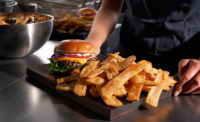The survey found adults consume more than 5.6 meals away from home each week, with breakfasts showing the largest gain in 2005, rising nearly 20% from the previous year.
“Our research suggests that more education and simplified nutrition information is needed,” said Chris Malone, senior vice president of marketing at Aramark. “It also shows that we need to better understand when people form their nutritional habits, how they change over time and what kinds of guidance and promotion are effective at encouraging better choices.”
The exodus from low-carb dieting led to a drop in respondents “attempting to watch their weight and limit their fat intake,” which fell from 33% to 29% in 2005. Weight loss and fat intake did stake a claim as the top nutritional concern, however, followed by monitoring sugar consumption (26%), cutting calories (22%) and limiting trans fatty acid intake (21%). Carbohydrate concerns dropped from 23% of respondents in 2004 to 18% in 2005. Still, 44% “strongly agreed” they would select healthful menu items more often away from home if more-appealing options were available.
Its research has prompted Aramark to introduce the Nutritional DiningStyles Calculator, an online guide (www.dining style.com) that asks consumers dining-related questions and classifies them into one of six dining categories. It then provides nutritional guidance and education.





